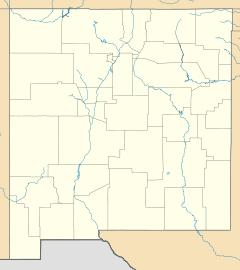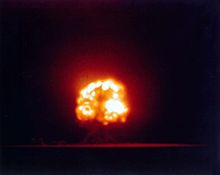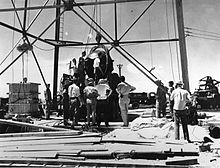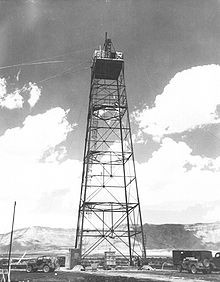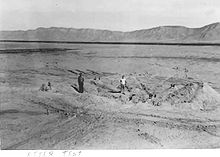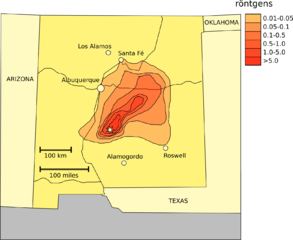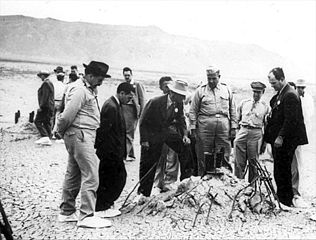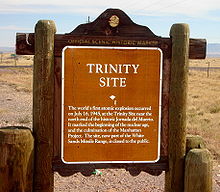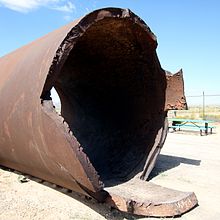- Trinity (nuclear test)
-
For other uses, see Trinity (disambiguation).
Trinity 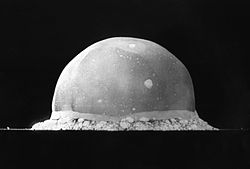
The Trinity explosion, 0.016 seconds after detonation. The fireball is about 600 feet (200 m) wide.
The black specks silhouetted along the horizon are trees.Information Country United States Test site Trinity Site, New Mexico Date July 16, 1945 Test type Atmospheric Device type Fission Yield 20 kilotons of TNT (84 TJ) Navigation Previous test none Next test Operation Crossroads Trinity Site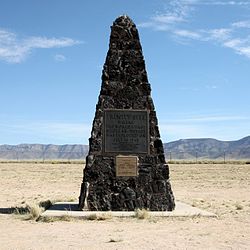 Trinity Site Obelisk
Trinity Site ObeliskLocation: White Sands Missile Range Nearest city: San Antonio, New Mexico Coordinates: 33°40′38.28″N 106°28′31.44″W / 33.6773°N 106.4754°WCoordinates: 33°40′38.28″N 106°28′31.44″W / 33.6773°N 106.4754°W Area: 36,480 acres (147.6 km2)[1] Built: 1945 NRHP Reference#: 66000493 Significant dates Added to NRHP: October 15, 1966[2] Designated NHLD: December 21, 1965[3] Trinity was the code name of the first test of a nuclear weapon. This test was conducted by the United States Army on July 16, 1945,[4][5][6][7][8] in the Jornada del Muerto desert about 35 miles (56 km) southeast of Socorro, New Mexico, at the new White Sands Proving Ground, which incorporated the Alamogordo Bombing and Gunnery Range. (The site is now the White Sands Missile Range.)[9][10] The date of the test is usually considered to be the beginning of the Atomic Age.
Trinity was a test of an implosion-design plutonium device. The weapon's informal nickname was "The Gadget".[11] Using the same conceptual design, the Fat Man device was detonated over Nagasaki, Japan, on August 9, 1945. The Trinity detonation produced an explosive power equivalent to the explosion of about 20 kilotons of TNT.
Contents
History
Main article: Manhattan ProjectThe creation of atomic weapons arose out of political and scientific developments of the late 1930s. The rise of fascist governments in Europe, new discoveries about the nature of atoms and the fear that Nazi Germany was working on developing atomic bombs converged in the plans of the United States, the United Kingdom, and Canada to develop powerful weapons using nuclear fission as their primary source of energy. The Manhattan Project, as the American nuclear physics effort was called, culminated in the test of a nuclear weapon at what is now called the Trinity Site on July 16, 1945, and the atomic bombings of Hiroshima and Nagasaki just a few weeks later.
The Manhattan Project
 The two types of fission-bomb assembly methods investigated during the Manhattan Project. The gun-type assembly was not tested before it was detonated at Hiroshima. However, because of the novel and untried features of the implosion-bomb design, Fat Man, J. Robert Oppenheimer and the other scientists at Los Alamos decided that it was necessary to test this one before attempting to utilize one as a weapon against the enemy.
The two types of fission-bomb assembly methods investigated during the Manhattan Project. The gun-type assembly was not tested before it was detonated at Hiroshima. However, because of the novel and untried features of the implosion-bomb design, Fat Man, J. Robert Oppenheimer and the other scientists at Los Alamos decided that it was necessary to test this one before attempting to utilize one as a weapon against the enemy.
While U.S. and British attempts to investigate the feasibility of nuclear weapons began as early as 1939, practical development began in earnest in 1942 when these efforts were transferred to the authority of the U.S. Army and became the Manhattan Project. The weapons-development portion of this project was located at the Los Alamos Laboratory in northern New Mexico, though much other development and production work was carried out at the Clinton Engineer Works near Oak Ridge, Tennessee (the separation of uranium-235); the Hanford Engineer Works near Hanford, Washington (the production and separation of plutonium-239); in and near Chicago, Illinois (at the University of Chicago and at the Argonne National Laboratories); and at the University of California, Berkeley.
These research, development, and production efforts focused both on the development of the necessary fissile materials to power the nuclear chain reactions in the atomic bombs and on the design, testing, and manufacture of the bombs themselves.[12]
From January 1944 until July 1945, large-scale production plants were set in operation, and the fissile material thus produced was then used to determine the features of the weapons. Multi-pronged research was undertaken to pursue several possibilities for bomb design. Early decisions about weapon design had been based on minute quantities of uranium-235 and plutonium that had been created in pilot plants and in physics-laboratory cyclotrons. From these experimental results, it was thought that the creation of a bomb was as simple as forming a critical mass of fissile material.[13]
The productions of both uranium-235 and plutonium-239 were massive undertakings given the technology of the 1940s and accounted for 80% of the total costs of the project.[14] Theoretically, enriching uranium was feasible through pre-existing techniques in physics (e.g., modifying particle accelerator technology), though it proved difficult to scale to industrial levels and was extremely costly.
Plutonium, by contrast, could theoretically be produced most easily in nuclear reactors, but the technology and science involved was wholly new. The first experimental nuclear reactor had been developed and constructed by Enrico Fermi and his team of co-workers by the end of 1942 at the University of Chicago (CP-1), which proved that there were no obvious physical limitations to producing a slow-neutron nuclear chain reaction. Work began on constructing massive plutonium-breeding reactors at Hanford, Washington, in October 1943. The first reactor-bred plutonium was produced in the B-Reactor, the first full-scale plutonium-production reactor in the world. The first large batch of plutonium was refined at Hanford in the "221-T plant", using the bismuth phosphate process, from December 26, 1944, to February 2, 1945. This was delivered to Oppenheimer's team at the Los Alamos laboratory on February 5, 1945. In the meantime, the X-10 Graphite Reactor, a scaled-down version of the Hanford reactors, was built in Oak Ridge, Tennessee, and went into operation in November 1943.
Plutonium is a synthetic element not found in nature in appreciable quantities. It also has relatively complicated physics, chemistry, and metallurgy compared to most other elements in the periodic table. The only prior plutonium isolated for the project had been produced in cyclotrons in very minute amounts. In April 1944, Emilio Segrè received the first sample of reactor-bred plutonium from the X-10 reactor and discovered that reactor-grade plutonium was not as pure as cyclotron-produced plutonium by a significant degree. Specifically, the longer the plutonium remained irradiated inside the reactor — which is necessary for high yields of the metal — the greater its content of the isotope plutonium-240. Pu-240 undergoes spontaneous fission at an appreciable rate, and that releases plenty of excess thermal neutrons. These extra neutrons implied a high probability that a gun-type bomb with plutonium would detonate too early, before a critical mass was formed, scattering the plutonium and producing a small "fizzle" of a nuclear explosion many times smaller than a full explosion. The practical result is that a simple gun-type atomic bomb (the proposed Thin Man) would not work as had been hoped.
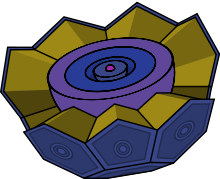 A diagram showing the bottom half of an implosion design similar to the one used in the Trinity gadget. The neutron initiator is at the center, surrounded by the plutonium core, surrounded by a pusher and tamper, surrounded by the explosive lenses, all within a casing. This diagram is not a literal depiction of the Trinity gadget and contains a few elements not found in the actual gadget.
A diagram showing the bottom half of an implosion design similar to the one used in the Trinity gadget. The neutron initiator is at the center, surrounded by the plutonium core, surrounded by a pusher and tamper, surrounded by the explosive lenses, all within a casing. This diagram is not a literal depiction of the Trinity gadget and contains a few elements not found in the actual gadget.
The impossibility of solving this problem of a gun-type bomb with plutonium was decided upon in a meeting in Los Alamos on June 17, 1944.[15] This forced a search for a different, more practical design of a plutonium-fueled bomb, and an implosion-type atomic-bomb design (i.e., the Fat Man design) was selected as the most practical one at that time. However, even this notion required a great deal of research work and experimentation in engineering and hydrodynamics before a practical design could be worked out.
In an implosion bomb, a small spherical core of plutonium would be surrounded by high explosives that burned with different speeds. By alternating the faster and slower burning explosives in a carefully calculated spherical configuration, they would produce a compressive wave upon their simultaneous detonation. This "lensing" effect focused the explosive force inward with enough force to physically compress the plutonium core to several times its original density. This would nearly instantly reduce the necessary size of the critical mass of the material, making it supercritical. It would also activate a small neutron source kept at the center of the core, which would assure that the chain reaction began in earnest.
The advantage of the implosion method was that it was far more efficient in use of material — only 6.2 kg of plutonium would be needed for a full explosion, compared to the 64 kg of enriched uranium used in the "Little Boy" weapon. The engineering difficulties, though, were daunting. Though explosive lenses had been pursued during the war, the art was still very new, and the tolerances required in terms of timing and symmetry were unprecedented. Should the timing or symmetry be off, the bomb would not detonate fully, and instead just disperse the plutonium into the surrounding area. The entire Los Alamos laboratory was reorganized in 1944 to focus on designing a workable implosion bomb.
The difficulty in designing the implosion weapon, and having confidence in its success, was so great that it was decided that a full-sized test would be required before any military use, even though it would sacrifice one of a very small number of possible bombs. Definite plans for a July 1945 implosion test were finalized in early 1944. The uranium weapon would not be tested; its success could be more or less guaranteed by measurements ahead of time.
The actual Fat Man atomic bomb, which used the same design as in the Trinity test, was exploded over Nagasaki on August 9, 1945, after the Trinity test had proven its operability in an atomic explosion.
The gadget
"The gadget" was the code name given to the first bomb tested.[16] It was so called because it was not a deployable weapon and because revealing words like bomb were not used during the project for fear of espionage. It was an implosion-type plutonium device, similar in design to the Fat Man bomb used three weeks later in the atomic bombing of Nagasaki, Japan.
A subcritical sphere of plutonium was placed in the center of a hollow sphere of high explosive. Numerous detonators located on the surface of the high explosive were fired simultaneously to produce a powerful inward pressure on the core, squeezing it and increasing its density, resulting in a supercritical condition and a nuclear explosion.
 Schematic cross-section of the gadget. See Fat Man article for details.
Schematic cross-section of the gadget. See Fat Man article for details.
The initial design, based on work done using cyclotron-supplied plutonium, was envisioned as a gun-type device, akin to the Little Boy uranium bomb. However, mass-produced plutonium emitted enough neutrons to make it likely that it would pre-detonate with low yield, making this design, known as "Thin Man", unusable.
Subsequently, an implosive design was selected, resulting in the design known as Fat Man. Both Fat Man and the gadget are not strictly "Fat Man type", as the design was modified into a production design, and both were strictly one-off prototypes.
The gadget was tested at Trinity Site, New Mexico, near Alamogordo. For the test, the gadget was lifted to the top of a 100-foot (30 m) bomb tower. It was feared by some that the Trinity test might "ignite" the earth's atmosphere, eliminating all life on the planet, although a classified report produced several years earlier had demonstrated that this was not possible.[17] Less wild estimates thought that New Mexico would be incinerated. Calculations showed that the yield of the device would be between 0 (if it did not work) and 20 kilotons (metric, equivalence of TNT). In the aftermath of the test, it appeared to have been a blast equivalent to 18 kt of TNT.
Test planning
In March 1944, planning for the test was assigned to Kenneth Bainbridge, a professor of physics at Harvard University, working under explosives expert George Kistiakowsky. A site had to be located that would guarantee secrecy of the project's goals even as a nuclear weapon of unknown strength was detonated. Proper scientific equipment had to be assembled for retrieving data from the test itself, and safety guidelines had to be developed to protect personnel from the unknown results of a highly dangerous experiment. Official test photographer Berlyn Brixner set up dozens of cameras to capture the event on film.
Test site
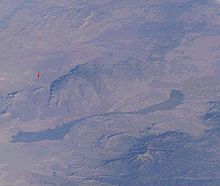 Trinity Site (red arrow) near Carrizozo Malpais
Trinity Site (red arrow) near Carrizozo Malpais
The heads of the project considered eight candidate sites, including San Nicolas Island (California), Padre Island (Texas), San Luis Valley, El Malpais National Monument, and other parts of New Mexico. A Mojave Desert Army base near Rice, California was considered the best location, but was opted against because General Leslie Groves, military head of the project, did not wish to have any dealings with Gen. George S. Patton, commander of the base, whom he disliked.[18] The site finally chosen was at the northern end of the White Sands Proving Ground, in Socorro County between the towns of Carrizozo and San Antonio, in the Jornada del Muerto in the southwestern United States (33°40′38″N 106°28′31″W / 33.6773°N 106.4754°W).[19] In the fall of 1944, soldiers started arriving at Trinity Site to prepare for the test. Sgt. Marvin Davis and his military police unit arrived at the site from Los Alamos on December 30, 1944. This unit set up initial security checkpoints around the area, with plans to use horses for patrols. The distances around the site proved too great, so they resorted to using jeeps and trucks for transportation.
Throughout 1945, other personnel arrived at Trinity Site to help prepare for the bomb test. As the soldiers at Trinity Site settled in, they became familiar with Socorro County. They tried to use water out of the ranch wells, but found the water so alkaline they could not drink it. They were forced to use U.S. Navy saltwater soap and hauled drinking water in from the firehouse in Socorro. Gasoline and diesel fuel were purchased from the Standard Oil bulk plant in Socorro.
Two bunkers were set up to observe the test. Oppenheimer and Brig. Gen. Thomas Farrell watched from a bunker ten miles (16 km) from the detonation, while Gen. Leslie Groves watched at a bunker seventeen miles (27 km) away.
Name
The exact origin of the name is unknown, but it is often attributed to laboratory leader J. Robert Oppenheimer as a reference to the poetry of John Donne. In 1962, General Groves wrote to Oppenheimer about the origin of the name, asking if he had chosen it because it was a name common to rivers and peaks in the West and would not attract attention, and elicited this reply:[20]
I did suggest it, but not on that ground... Why I chose the name is not clear, but I know what thoughts were in my mind. There is a poem of John Donne, written just before his death, which I know and love. From it a quotation: "As West and East / In all flatt Maps—and I am one—are one, / So death doth touch the Resurrection."[21][22] That still does not make a Trinity, but in another, better known devotional poem Donne opens, "Batter my heart, three person'd God;—."[23][24]Test predictions
The observers set up betting pools on the results of the test.[25][26] Predictions ranged from zero (a complete dud) to 45 kilotons of TNT, to destruction of the state of New Mexico, to ignition of the atmosphere and incineration of the entire planet. This last result had been calculated to be almost impossible,[27] although for a while it caused some of the scientists some anxiety. Physicist I. I. Rabi won the pool with a prediction of 18 kilotons.[28]
Test preparation
There was a pretest explosion of 108 tons of TNT, spiked with 1,000 curies (37 TBq) of fission products from the Hanford reactor, on May 7 to calibrate the instruments. (Nuclear detonation yields have always been measured by the equivalent in tons of TNT.)
For the actual test, the plutonium-core nuclear device, nicknamed "the gadget", was hoisted to the top of a 100-foot-tall steel tower (30 m) for detonation — the height would give a better indication of how the weapon would behave when dropped from an airplane, as detonation in the air would maximize the amount of energy applied directly to the target (as it expanded in a spherical shape) and would generate less nuclear fallout.
The gadget was assembled at the nearby McDonald Ranch House on July 13, the components having arrived on July 12. After assembly, it was carefully winched up the tower the following day. General Groves had ordered the construction of a 214-ton steel canister code-named "Jumbo" to recover valuable plutonium if the five tons of conventional explosives failed to compress it into a chain reaction. The container was constructed at great expense in Pittsburgh, Pennsylvania, and brought to the test site by rail, but by the time it arrived, the confidence of the scientists was high enough that they decided not to use it. Instead, it was hoisted up in a steel tower 800 yards (730 m) from the gadget as a rough measure of how powerful the explosion would be. In the end, Jumbo survived, though its tower did not.
The detonation was initially planned for 4:00 am but was postponed because of rain and lightning from early that morning. It was feared that the danger from radiation and fallout would be greatly increased by rain, and lightning had the scientists concerned about accidental detonation.[29]
Explosion
Video of Trinity test
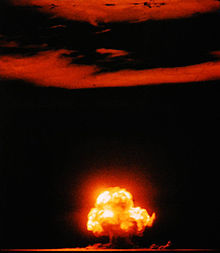 Color photograph of the Trinity explosion by Jack Aeby.
Color photograph of the Trinity explosion by Jack Aeby.
At 4:45 am, a crucial weather report came in favorably, and, at 5:10 am, the twenty-minute countdown began. Most top-level scientists and military officers were observing from a base camp ten miles (16 km) southwest of the test tower. Many other observers were around twenty miles (32 km) away, and some others were scattered at different distances, some in more informal situations (physicist Richard Feynman claimed to be the only person to see the explosion without the dark glasses provided, relying on a truck windshield to screen out harmful ultraviolet wavelengths[30]). The final countdown was read by physicist Samuel K. Allison.
At 05:29:45 local time (Mountain War Time), the device exploded with an energy equivalent to around 20 kilotons of TNT (90 TJ). It left a crater of radioactive glass in the desert 10 feet (3 m) deep and 1,100 feet (330 m) wide. At the time of detonation, the surrounding mountains were illuminated "brighter than daytime" for one to two seconds, and the heat was reported as "being as hot as an oven" at the base camp. The observed colors of the illumination ranged from purple to green and eventually to white. The roar of the shock wave took 40 seconds to reach the observers.[26] The shock wave was felt over 100 miles (160 km) away, and the mushroom cloud reached 7.5 miles (12 km) in height. After the initial euphoria of witnessing the explosion had passed, test director Kenneth Bainbridge commented to Los Alamos director J. Robert Oppenheimer, "Now we are all sons of bitches."[31] Oppenheimer later stated that, while watching the test, he was reminded of a line from the Hindu scripture the Bhagavad Gita:
In the official report on the test, General Farrell wrote, "The lighting effects beggared description. The whole country was lighted by a searing light with the intensity many times that of the midday sun. It was golden, purple, violet, gray, and blue. It lighted every peak, crevasse and ridge of the nearby mountain range with a clarity and beauty that cannot be described but must be seen to be imagined..."[34]
News reports quoted a forest ranger 150 miles (240 km) west of the site as saying he saw "a flash of fire followed by an explosion and black smoke." A New Mexican 150 miles (240 km) north said, "The explosion lighted up the sky like the sun." Other reports remarked that windows were rattled and the sound of the explosion could be heard up to 200 miles (320 km) away.
John R. Lugo was flying a U.S. Navy transport at 10,000 feet (3,000 m), 30 miles (48 km) east of Albuquerque, en route to the west coast. "My first impression was, like, the sun was coming up in the south. What a ball of fire! It was so bright it lit up the cockpit of the plane." Lugo radioed Albuquerque. He got no explanation for the blast but was told, "Don't fly south."[35]
In the crater, the desert sand, which is largely made of silica, melted and became a mildly radioactive light green glass, which was named Trinitite.[36] The crater was filled in soon after the test.
The Alamogordo Air Base issued a 50-word press release in response to what it described as "several inquiries" that had been received concerning an explosion. The release explained that "a remotely located ammunitions magazine containing a considerable amount of high explosives and pyrotechnics exploded," but that "there was no loss of life or limb to anyone." A newspaper article published the same day stated that "the blast was seen and felt throughout an area extending from El Paso to Silver City, Gallup, Socorro, and Albuquerque."[37] The actual cause was not publicly acknowledged until after the August 6 bombing of Hiroshima.
The Manhattan Project's official journalist, William L. Laurence, had put multiple press releases on file with his office at The New York Times to be released in case of an emergency, ranging from an account of a successful test (the one which was used) to more macabre scenarios explaining why all of the scientists had perished in a single freak accident.[38]
Around 260 personnel were present, none closer than 5.6 miles (9 km). At the next test series, Operation Crossroads in 1946, over 40,000 people were present.[39]
The official technical report (LA-6300-H) on the history of the Trinity test was not released until May 1976.[40]
Test results
The results of the test were conveyed to President Harry S Truman, who was eagerly awaiting them at the Potsdam Conference; the coded message ("Operated this morning. Diagnosis not complete but results seem satisfactory and already exceed expectations. . . . Dr. Groves pleased.") arrived at 7:30 p.m. on July 16 and was at once taken to the president and Secretary of State James F. Byrnes at the "Little White House" in the Berlin suburb of Babelsberg by Secretary of War Henry L. Stimson.[41] Information about the Trinity test was made public shortly after the bombing of Hiroshima. The Smyth Report, released on August 12, 1945, gave some information on the blast, and the hardbound edition released by Princeton University Press a few weeks later contained the famous pictures of a "bulbous" Trinity fireball.
Oppenheimer and Groves posed for reporters near the remains of the mangled test tower shortly after the war. In the years after the test, the pictures have become a potent symbol of the beginning of the so-called Atomic Age, and the test has often been featured in popular culture.
-
Maj. Gen. Leslie R. Groves and Robert Oppenheimer at the Trinity shot tower remains a few weeks later
First deployment
Main article: Atomic bombings of Hiroshima and NagasakiFollowing the success of the Trinity test, two bombs were prepared for use against Japan during World War II. The first, dropped on Hiroshima, Japan, on August 6, was code-named "Little Boy", and used uranium-235 as its fission source. It was an untested design but was considered very likely to work and was considerably simpler than the implosion model. It could not be tested, because there was only enough uranium-235 for one bomb. The second bomb, dropped on Nagasaki, Japan, on August 9, was code-named "Fat Man" and was a plutonium bomb of the type tested at Trinity. The atomic bombings of Hiroshima and Nagasaki killed at least 148,000 people immediately and many more over time. By 1950, the death toll was over 340,000.[42] They were followed days later by the surrender of Japan. Debate over the justification of the use of nuclear weapons against Japan persists to this day, both in scholarly and popular circles.
Site today
In 1952, the site of the explosion was bulldozed, and the remaining trinitite was disposed of. On December 21, 1965, the 51,500-acre (20,800 ha) area Trinity Site was declared a National Historic Landmark district[1][3] and, on October 15, 1966, was listed on the National Register of Historic Places .[2]
The landmark includes the base camp, where the scientists and support group lived; ground zero, where the bomb was placed for the explosion; and the Schmidt/McDonald ranch house, where the plutonium core to the bomb was assembled. Visitors to a Trinity Site open house are allowed to see the ground zero and ranch house areas. In addition, one of the old instrumentation bunkers is visible beside the road just west of ground zero.
In September 1953, about 650 people attended the first Trinity Site open house. In recent years, the site has been opened for public visits twice each year, on the first Saturdays in April and October.[43]
In 1967, the inner oblong fence was added. In 1972, the corridor barbed wire fence that connects the outer fence to the inner one was completed. Jumbo was moved to the parking lot in 1979.
More than sixty years after the test, residual radiation at the site measured about ten times higher than normal.[44] The amount of radioactive exposure received during a one-hour visit to the site is about half of what a U.S. adult receives on an average day from natural and medical sources.[45] The Trinity monument, a rough-sided, lava-rock obelisk around 12 feet (3.65 m) high, marks the explosion's hypocenter, and Jumbo is still kept nearby.
On July 16, 2005, a special tour of the site was conducted to mark the 60th anniversary of the Trinity test, and hundreds (some news sources reported thousands) of visitors arrived to commemorate the occasion. The site is still a popular destination for those interested in atomic tourism, though it is only open to the public twice a year during open houses, on the first Saturdays of April and October. The Trinity Site Open House was free until 2011, when entrance fees were instated due to budget constraints.[46] (Passenger Vehicle - $25, Buses - $100, Motorcycles - $10)
See also
- First Lightning (RDS-1) (Joe-1): the first Soviet atomic bomb test (with a device modeled after the type used at the Trinity test)
- Atomic bombings of Hiroshima and Nagasaki
- Nuclear weapons and the United States
- List of nuclear tests
- The Day After Trinity, a 1980 documentary film
- Trinity, a 1986 interactive fiction Infocom computer game that centers around the Trinity test
- Day One, a 1989 film
- Doctor Atomic, an opera about the Trinity test
- Trinity and Beyond, a 1995 documentary film
- Ivy Mike, the codename given to the first United States nuclear test of a fusion device on November 1, 1952
- Above and Beyond, a 1952 film about the planning and dropping of the atomic bomb on Hiroshima
- Fat Man and Little Boy, a 1989 film that reenacts the Manhattan Project
- Carnivàle, an HBO television series in which the nuclear testing features prominently.
References
- ^ a b Richard Greenwood (January 14, 1975) (PDF). National Register of Historic Places Inventory-Nomination: Trinity Site. National Park Service. http://pdfhost.focus.nps.gov/docs/NHLS/Text/66000493.pdf. Retrieved 2009-06-21 and Accompanying 10 photos, from 1974.PDF (3.37 MB)
- ^ a b "National Register Information System". National Register of Historic Places. National Park Service. 2007-01-23. http://nrhp.focus.nps.gov/natreg/docs/All_Data.html.
- ^ a b "Trinity Site". National Historic Landmarks. National Park Service. http://tps.cr.nps.gov/nhl/detail.cfm?ResourceID=351&resourceType=District. Retrieved 2008-01-28.
- ^ Ferenc Morton Szasz, The Day The Sun Rose Twice: The Story of the Trinity Site Nuclear Explosion July 16, 1945 (University of New Mexico Press, 1984). ISBN 978-0-8263-0768-2
- ^ "The First Atomic Bomb Blast, 1945". Eyewitnesstohistory.com. http://www.eyewitnesstohistory.com/atomictest.htm. Retrieved 2010-02-28.
- ^ Chris Demarest. "Atomic Bomb-Truman Press Release-August 6, 1945". Trumanlibrary.org. http://www.trumanlibrary.org/teacher/abomb.htm. Retrieved 2010-02-28.
- ^ "Final Preparations for Rehearsals and Test | The Trinity Test | Historical Documents". atomicarchive.com. http://www.atomicarchive.com/Docs/Trinity/FinalPreparations.shtml. Retrieved 2010-02-28.
- ^ "TRINITY TEST - JULY 16, 1945". Radiochemistry.org. http://www.radiochemistry.org/history/nuke_tests/trinity/index.html. Retrieved 2010-02-28.
- ^ "Safety and the Trinity Test, July 1945". Cfo.doe.gov. http://www.cfo.doe.gov/me70/manhattan/trinity_safety.htm. Retrieved 2010-02-28.
- ^ "Atomic Bomb: Decision - Trinity Test, July 16, 1945". Dannen.com. http://www.dannen.com/decision/trin-rad.html. Retrieved 2010-02-28.
- ^ Kathryn Westcott: bbc.co.uk The day the world lit up, BBC, Friday, 15 July 2005.
- ^ Hans Bethe (1991), The Road from Los Alamos. American Institute of Physics ISBN 0-671-74012-1
- ^ "The Manhattan Project / Making the Atomic Bomb" (PDF). United States Department of Energy. 1999. http://www.osti.gov/accomplishments/pdf/DE99001330/DE99001330.pdf. Retrieved 2008-01-24.
- ^ The Costs of the Manhattan Project, Brookings Institution (accessed 10 August 2010)
- ^ Manhattan Project Chronology at AtomicArchive.com
- ^ Kathryn Westcott: The day the world lit up, BBC, Friday, 15 July 2005, bbc.co.uk.
- ^ "Report LA-602, ''Ignition of the Atmosphere With Nuclear Bombs''" (PDF). http://www.fas.org/sgp/othergov/doe/lanl/docs1/00329010.pdf. Retrieved 2011-10-19.
- ^ "Trinity Atomic Web Site". Walker, Gregory. http://www.cddc.vt.edu/host/atomic/trinity/trinity1.html. Retrieved 2010-08-20.
- ^ "Trinity Site". White Sands Missile Range. Archived from the original on 2008-06-01. http://web.archive.org/web/20080601033016/http://www.wsmr.army.mil/pao/TrinitySite/trinst.htm. Retrieved 2007-07-16. "GPS Coordinates for obelisk (exact GZ) = N33.40.636 W106.28.525"
- ^ Richard Rhodes, The Making of the Atomic Bomb (New York: Simon and Shuster, 1986), pp. 571–572.
- ^ John Donne, "Hymne to God My God, in My Sicknesse". The excerpt is about half of the third five-line stanza out of six.
- ^ Hymn to god, my god, in my sickness Source: Donne, John. Poems of John Donne. vol I. E. K. Chambers, ed. London: Lawrence & Bullen, 1896. 211–212.
- ^ John Donne, Holy Sonnets, XIV. The clause is the truncated first line of a four-line sentence from the (14-line) sonnet.
- ^ Holy sonnets. XIV Source: Donne, John. Poems of John Donne. vol I. E. K. Chambers, ed. London: Lawrence & Bullen, 1896. 165.
- ^ Rhodes, pages 656 and 664.
- ^ a b James Hershberg (1993), James B. Conant: Harvard to Hiroshima and the Making of the Nuclear Age. 948 pp. ISBN 0-394-57966-6 p. 233
- ^ Konopinski, E. J; Marvin, C.; Teller, Edward (1946, declassified February 1973). "Ignition of the Atmosphere with Nuclear Bombs" (PDF). http://www.fas.org/sgp/othergov/doe/lanl/docs1/00329010.pdf. Retrieved 23 November 2008
- ^ Rhodes, p. 677.
- ^ "Countdown" (PDF). Los Alamos: Beginning of an Era, 1943–1945. Los Alamos Scientific Laboratory. ca. 1967–1971. http://www.cfo.doe.gov/me70/manhattan/publications/LANLBeginningofEraPart5.pdf. Retrieved 2008-01-24.
- ^ Richard Feynman (2000), The Pleasure of Finding Things Out p. 53–96 ISBN 0-7382-0349-1
- ^ "The Trinity Test". United States Department of Energy. http://www.cfo.doe.gov/me70/manhattan/trinity.htm. Retrieved 2009-04-08.
- ^ Variants on this quotation exist, both by Oppenheimer and by others. A more common translation of the passage, from Arthur W. Ryder (from whom Oppenheimer studied Sanskrit at Berkeley in the 1930s), is:
- Death am I, and my present task
- Destruction. (11:32)
- If the radiance of a thousand suns
- were to burst into the sky,
- that would be like
- the splendor of the Mighty One—
- I am become Death, the shatterer of Worlds.
- ^ Richard Rhodes, The Making of the Atomic Bomb (New York: Simon and Shuster, 1986). Quotes after the test from p. 675–676.
- ^ "Chronology on Decision to Bomb Hiroshima and Nagasaki". http://www.nuclearfiles.org/menu/key-issues/nuclear-weapons/history/pre-cold-war/hiroshima-nagasaki/decision-drop-bomb-chronology.htm.
- ^ The Trinity Test: Eyewitnesses[dead link]
- ^ P.P. Parekh; T.M. Semkow, M.A. Torres, D.K. Haines, J.M. Cooper, P.M. Rosenberg and M.E. Kitto (2006). "Radioactivity in Trinitite six decades later". Journal of Environmental Radioactivity 85 (1): 103–120. doi:10.1016/j.jenvrad.2005.01.017. PMID 16102878.
- ^ "Army Ammunition Explosion Rocks Southwest Area," El Paso Herald-Post, 1945-7-16, p.1 (quoting the full press release)(retrieved from Newspaperarchive.com 2007-8-15).
- ^ William L. Laurence, "Now We Are All Sons-of-Bitches," Science News vol. 98, no. 2 (11 July 1970): pp. 39–41.
- ^ "Operation Crossroads: Fact Sheet". Department of the navy—naval historical center. 2002-08-11. http://www.history.navy.mil/faqs/faq76-1.htm. Retrieved 2008-01-24.
- ^ Bainbridge, K.T., Trinity (Report LA-6300-H), Los Alamos Scientific Laboratory.
- ^ Gar Alperovitz, The Decision to Use the Atomic Bomb and the Architecture of an American Myth (New York: Alfred A. Knopf, 1995), p. 240.
- ^ From: Hughes, Jeff. The Manhattan Project: Big Science and The Atom Bomb. New York: Columbia University Press, 2002. (p.95)
- ^ "military". White Sands, New Mexico. http://www.white-sands-new-mexico.com/military.htm. Retrieved 2011-10-19.
- ^ Brian Greene (2003), Nova: The Elegant Universe: Einstein's Dream. PBS Nova transcript Regarding residual radiation.
- ^ WSMR article on Trinity nuclear test site[dead link]
- ^ "Entrance fee to be charged for future Trinity Site open houses". http://www.wsmr.army.mil/PAO/Trinity/Pages/default.aspx. Retrieved April 29, 2011.
External links
- Official report LA-6300-H by Bainbridge, declassified as a "comprehensive record" in 1976 and containing "almost all the original text previously published as LA-1012".
- Very High Resolution Photograph of The Trinity Obelisk
- Trinity Remembered: 60th Anniversary
- BBC article on the 60th Anniversary
- Atomic tourism: Information for visitors
- The Trinity test on the Los Alamos National Laboratory website
- Carey Sublette's Nuclear Weapon Archive Trinity page
- The Trinity test on the Sandia National Laboratories website
- The Trinity test on the White Sands Missile Range website
- Richard Feynman, "Los Alamos from Below"; Surely, You're Joking, Mr. Feynman.
- Trinity Test Fallout Pattern
- Trinity Test Photographs
- Trinity: First Test of the Atomic Bomb
- "My Radioactive Vacation", report of a visit to the Trinity site, with pictures comparing its past with its present state
- Visiting Trinity Short article by Ker Than at 3 Quarks Daily
- "War Department release on New Mexico test, July 16, 1945", from the Smyth Report, with eyewitness reports from Gen. Groves and Gen. Farrell (1945)
- Trinity Site National Historic Landmark
- Trinity A bomb test photos on The UK National Archives' website.
- Annotated bibliography for the Trinity Test from the Alsos Digital Library for Nuclear Issues
- Video of the Trinity Weapon Test at sonicbomb.com
Manhattan Project Sites 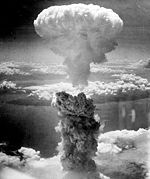
Administrators Vannevar Bush · James Conant · Thomas Farrell · Leslie Groves · Franklin Matthias · Kenneth Nichols · Robert Oppenheimer · William ParsonsScientists Hans Bethe · Niels Bohr · James Chadwick · Arthur Compton · Enrico Fermi · Richard Feynman · Klaus Fuchs · George Kistiakowsky · Ernest Lawrence · William Penney · Emilio G. Segrè · Glenn T. Seaborg · Leó Szilárd · Edward Teller · Richard C. Tolman · Stanislaw Ulam · Harold Urey · Leona Woods · Chien-Shiung WuRelated articles Timeline · History of nuclear weapons · Nuclear weapons and the United States · S-1 Uranium Committee · Chicago Pile-1 · X-10 Graphite Reactor · Y-12 National Security Complex · Operation Alsos · Smyth Report · Project Alberta · 509th Operations Group · Fat Man · Little Boy · Enola Gay · Bockscar · The Great Artiste · Atomic bombings of Hiroshima and Nagasaki (debate) · Atomic Spies · Atomic Energy Act of 1946 · Operation Crossroads · Tube AlloysU.S. National Register of Historic Places Topics Lists by states Alabama • Alaska • Arizona • Arkansas • California • Colorado • Connecticut • Delaware • Florida • Georgia • Hawaii • Idaho • Illinois • Indiana • Iowa • Kansas • Kentucky • Louisiana • Maine • Maryland • Massachusetts • Michigan • Minnesota • Mississippi • Missouri • Montana • Nebraska • Nevada • New Hampshire • New Jersey • New Mexico • New York • North Carolina • North Dakota • Ohio • Oklahoma • Oregon • Pennsylvania • Rhode Island • South Carolina • South Dakota • Tennessee • Texas • Utah • Vermont • Virginia • Washington • West Virginia • Wisconsin • WyomingLists by territories Lists by associated states Other Categories:- Historic districts in New Mexico
- 1945 in science
- 1945 in the United States
- American nuclear explosive tests
- Explosions in the United States
- History of New Mexico
- Manhattan Project
- National Historic Landmarks in New Mexico
- Nuclear history of the United States
- Nuclear test sites
- American nuclear test sites
- History of Socorro County, New Mexico
- Tularosa Basin
- Visitor attractions in Alamogordo, New Mexico
- 20th-century explosions
- Code names
- Visitor attractions in Socorro County, New Mexico
Wikimedia Foundation. 2010.

